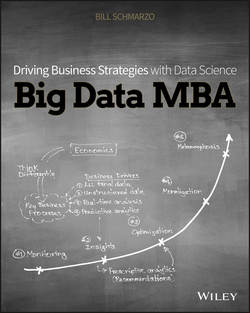Читать книгу Big Data MBA - Schmarzo Bill - Страница 4
Part I
Business Potential of Big Data
Chapter 1
The Big Data Business Mandate
Big Data MBA Introduction
ОглавлениеThe days when business users and business management can relinquish control of data and analytics to IT are over, or at least for organizations that want to survive beyond the immediate term. The big data discussion now needs to focus on how organizations can couple new sources of customer, product, and operational data with advanced analytics (data science) to power their key business processes and elevate their business models. Organizations need to understand that they do not need a big data strategy as much as they need a business strategy that incorporates big data.
The Big Data MBA challenges the thinking that data and analytics are ancillary or a “bolt on” to the business; that data and analytics are someone else's problem. In a growing number of leading organizations, data and analytics are critical to business success and long-term survival. Business leaders and business users reading this book will learn why they must take responsibility for identifying where and how they can apply data and analytics to their businesses – otherwise they put their businesses at risk of being made obsolete by more nimble, data-driven competitors.
The Big Data MBA introduces and describes concepts, techniques, methodologies, and hand-on exercises to guide you as you seek to address the big data business mandate. The book provides hands-on exercises and homework assignments to make these concepts and techniques come to life for your organization. It provides recommendations and actions that enable your organization to start today. And in the process, Big Data MBA teaches you to “think like a data scientist.”
The Forrester study “Reset on Big Data” (Hopkins et al., 2014)1 highlights the critical role of a business-centric focus in the big data discussion. The study argues that technology-focused executives within a business will think of big data as a technology and fail to convey its importance to the boardroom.
Businesses of all sizes must reframe the big data conversation with the business leaders in the boardroom. The critical and difficult big data question that business leaders must address is:
How effective is our organization at integrating data and analytics into our business models?
Before business leaders can begin these discussions, organizations must understand their current level of big data maturity. Chapter 2 discusses in detail the “Big Data Business Model Maturity Index” (see Figure 1.1). The Big Data Business Model Maturity Index is a measure of how effective an organization is at integrating data and analytics to power their business model.
Figure 1.1 Big Data Business Model Maturity Index
The Big Data Business Model Maturity Index provides a road map for how organizations can integrate data and analytics into their business models. The Big Data Business Model Maturity Index is composed of the following five phases:
• Phase 1: Business Monitoring. In the Business Monitoring phase, organizations are leveraging data warehousing and Business Intelligence to monitor the organization's performance.
• Phase 2: Business Insights. The Business Insights phase is about leveraging predictive analytics to uncover customer, product, and operational insights buried in the growing wealth of internal and external data sources. In this phase, organizations aggressively expand their data acquisition efforts by coupling all of their detailed transactional and operational data with internal data such as consumer comments, e-mail conversations, and technician notes, as well as external and publicly available data such as social media, weather, traffic, economic, demographics, home values, and local events data.
• Phase 3: Business Optimization. In the Business Optimization phase, organizations apply prescriptive analytics to the customer, product, and operational insights uncovered in the Business Insights phase to deliver actionable insights or recommendations to frontline employees, business managers, and channel partners, as well as customers. The goal of the Business Optimization phase is to enable employees, partners, and customers to optimize their key decisions.
• Phase 4: Data Monetization. In the Data Monetization phase, organizations leverage the customer, product, and operational insights to create new sources of revenue. This could include selling data – or insights – into new markets (a cellular phone provider selling customer behavioral data to advertisers), integrating analytics into products and services to create “smart” products, or re-packaging customer, product, and operational insights to create new products and services, to enter new markets, and/or to reach new audiences.
• Phase 5: Business Metamorphosis. The holy grail of the Big Data Business Model Maturity Index is when an organization transitions its business model from selling products to selling “business-as-a-service.” Think GE selling “thrust” instead of jet engines. Think John Deere selling “farming optimization” instead of farming equipment. Think Boeing selling “air miles” instead of airplanes. And in the process, these organizations will create a platform enabling third-party developers to build and market solutions on top of the organization's business-as-a-service business model.
Ultimately, big data only matters if it helps organizations make more money and improve operational effectiveness. Examples include increasing customer acquisition, reducing customer churn, reducing operational and maintenance costs, optimizing prices and yield, reducing risks and errors, improving compliance, improving the customer experience, and more.
No matter the size of the organization, organizations don't need a big data strategy as much as they need a business strategy that incorporates big data.
1
Hopkins, Brian, Fatemeh Khatibloo with Kyle McNabb, James Staten, Andras Cser, Holger Kisker, Ph.D., Leslie Owens, Jennifer Belissent, Ph.D., Abigail Komlenic, “Reset On Big Data: Embrace Big Data to Engage Customers at Scale,” Forrester Research, 2014.
